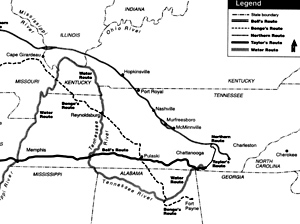
Trail of Tears, or Nunna-da-ul-tsun-yi
The Trail of Tears (or Nunna-da-ul-tsun-yi in the Cherokee language: “the place were they cried”), next to the practice of black slavery, is arguably the most tragic story in Tennessee history. Covering the period from May 1838 to March 1839, the Trail of Tears was the federal government’s final, forceful effort to remove the Cherokees from the land on which they lived in upper Georgia and southeastern Tennessee.
After the American Revolution, white settlers had pressed westward with little regard for the Native Americans until, by 1819, the new Americans claimed over 90 percent of the land east of the Mississippi River. Whites perceived the Cherokees as the most prominent obstacle blocking their claims in parts of Tennessee, Georgia, North Carolina, and Alabama. The Cherokees had developed an agricultural economy (based in part on black slave labor) and had established a constitutional republic patterned after the United States. The capital, New Echota in northern Georgia, promised to be a center of cultural activity with increasing educational opportunities for the Cherokees.
In 1828 Andrew Jackson, whose pioneer experiences had resulted in deep resentment against all Native Americans, was elected president of the United States. In his inaugural address, Jackson called for the relocation of all eastern Indians beyond the Mississippi River. A popular idea among white settlers, this presidential wish became federal law with the passage of the Indian Removal Act in 1830.
Compounding the problems of the Cherokees was the discovery of gold in Dahlonega, Georgia. Georgia officials immediately began devising a system of lotteries to distribute the Cherokee land and its supposed riches to white settlers. Suddenly denied the right to conduct tribal business under Georgia law, the Cherokees moved their capital to Red Clay, just across the Tennessee border. Not to be outdone, however, the Georgia governor allowed a minority group, led by Major Ridge, to gather at New Echota in December 1835 to sign a treaty ceding all eastern Cherokee holdings to the United States for $5 million and land west of the Mississippi River. Although the lawful Red Clay representatives protested the treaty through every legal channel, the U.S. Senate ratified the Treaty of New Echota on May 23, 1836, by a single vote.
Accepting what they considered to be inevitable, Major Ridge and some other pragmatic Cherokees salvaged what they could and proceeded at their discretion to their new homeland. But the majority, led by John Ross, refused to believe the federal government would resort to force to remove them from their ancestral land.
They were wrong. After two years of pleas and threats from various United States agencies, the roundup of the Cherokees began in May 1838 with seven thousand soldiers under the command of General Winfield Scott. The Cherokees were taken–young and old, poor and rich, along with their black slaves–with whatever possessions they could quickly gather before whites rushed in to claim their lottery winnings or to plunder what the unfortunate prisoners had been unable to take. The captives were taken to collection camps where most of them languished all summer while Indian representatives, most notably John Ross, and General Scott struggled with procedures for effecting their deportation.
Originally the plan called for transporting the Cherokees by keel boats constructed for that purpose by the federal government. The proposed water route followed the Tennessee River to the Mississippi River, then up the Arkansas River to the new Cherokee territory. During the summer, three groups did leave by water from present-day Chattanooga, but they experienced great difficulty because drought had reduced the river levels. As finally organized by Ross, the mass of the Cherokees traveled by land, the first group leaving on August 28, 1838. They were followed at intervals by twelve other groups, each numbering approximately one thousand Cherokees and blacks. The “Trail,” in fact, included three routes. One crossed Tennessee to Memphis, then moved along the Arkansas River to Cherokee land. A second route went from Fort Payne, Alabama, through West Tennessee to Missouri, then down through Arkansas to Oklahoma. The third progressed through Nashville to Kentucky, Illinois, and Missouri before dropping down near the northwestern corner of Arkansas.
Escorted by soldiers on horseback, the Cherokees were not prepared for the weather or the trauma of their trek. Lacking adequate clothing and food, often moving in deplorable weather conditions, more and more fell along the way. Each campsite served as a new burial ground, while the survivors moved on. Of the original estimated fourteen thousand marchers, it is believed that over four thousand died before reaching their destination.
Long relegated to a brief reference in American history texts, the Trail of Tears has now been brought to the forefront of American awareness as Native American cultures have begun to receive the appreciation and status they deserve. In 1987 the U.S. Congress established the Trail of Tears National Historic Trail, which is administered by the National Park Service with the cooperation of a wide range of interested parties, including the Cherokee Nation. The Trial of Tears Association, a nonprofit organization with headquarters in Little Rock, Arkansas, was founded in 1993 to work closely with the National Park Service in identifying and marking all of the land routes used in the forced march westward.
Suggested Reading
John Ehle, Trail of Tears: The Rise and Fall of the Cherokee Nation (1988); Louis Filler and Allen Guttmann, eds., The Removal of the Cherokee Nation (1977)



